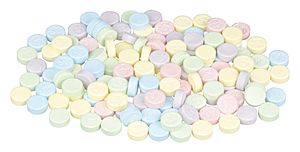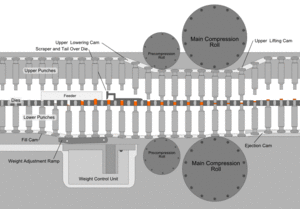Tableting facts for kids
Tableting is a cool way to press medicine or candy into solid shapes called tablets. Making candy tablets is actually quite similar to making medicine tablets!

First, a mix of powder or tiny grains is prepared. Then, this mix is put into a special mold. Next, it's squeezed very hard, and finally, the finished tablet pops out. Medicine tablets need to be easy to swallow, so they have specific shapes and sizes. But candy tablets can be chewed and come in many fun shapes and sizes!
Some examples of tablet candies you might know are Smarties, SweeTarts, and Necco Wafers.
Contents
- Making Tablets: A Step-by-Step Guide
- Getting Ready for You: Packaging
- Main Steps in Tablet Making
Making Tablets: A Step-by-Step Guide
Making solid medicines like tablets is a process with many steps. The starting materials change their physical form several times before becoming the final tablet.
Usually, tablets are made by a process called granulation. This makes sure the ingredients mix well and flow easily. There are two main types: wet granulation and dry granulation. Even if tablets are made by simply pressing the ingredients (direct compression) or by granulation, the first step is always the same: grinding and mixing. The steps after that can be different.
Many different steps are involved in making tablets. These include making particles smaller, mixing, granulation, drying, pressing, and often, coating them. How these steps are done can really affect how well the medicine works or how long it lasts.
Getting the Right Size: Sizing the Ingredients
Making sure all the ingredients are the right size is a super important step in making tablets. This process is also called milling, crushing, or grinding.
When making pressed tablets, it's much easier to mix different solid ingredients if they are all about the same size. This helps make sure every tablet has the correct amount of medicine. Having very fine particles is also key when mixing in a lubricant (something that helps the tablet slide out of the mold) so it works properly.
Smaller particles have some cool benefits:
- They have more surface area, which can help the medicine dissolve faster in your body.
- It's easier to get the same amount of medicine in every tablet because there are more tiny particles per weight.
- The mix flows better in the tablet machine if the particles are the right size.
- It helps colors and active ingredients spread evenly throughout the tablet.
- Wet granules (small clumps of powder) dry more evenly if they are all the same size.
If the sizing process isn't done correctly, some problems can pop up:
- The medicine's form might change, making it less effective or even unstable.
- The powder might become less dense, causing problems with flow and mixing.
- Smaller particles can sometimes trap air, which might make it harder for the medicine to dissolve.
Many different machines are used for grinding or milling, depending on whether the ingredients just need gentle sifting or serious grinding. Some common machines include:
- Fluid energy mill
- Colloidal mill
- Ball mill
- Hammer mill
- Conical mill
Mixing Powders: Blending for Success
Mixing powders well is harder than mixing liquids because it's tough to get a perfect blend. Powders can also stick together or resist moving, which makes it tricky. Sometimes, different particles can separate based on their size, shape, or weight, making the mix uneven. Powders can be mixed before or after the granulation step.
Every mixing process has a perfect mixing time. Mixing for too long can actually ruin the product. So, finding the right time and speed is very important! Simple tumble blenders are often used for mixing before pressing. Sometimes, special containers called "bins" are used that can be moved directly to the next step after blending. When mixing in a lubricant, it's especially important not to overmix.
Modern machines often combine several steps like mixing, granulation, and even drying to make the process faster and better.
Making Granules: Granulation
After the ingredients are sized and mixed, they might be turned into granules. This helps make sure the medicine is spread evenly throughout the mix. This step is super important and needs a lot of skill to get the right quality of granules before making tablets. The quality of the granules affects how smoothly the tablet-making process goes. If granulation isn't done right, the mix could even damage the tablet press machine!
Getting Dry: The Drying Process
Drying is another key step in making medicine. It's important to remove enough moisture to prevent the product from spoiling and to make sure the powders flow freely. Common dryers include:
- Fluidized-bed dryer
- Vacuum tray dryer
- Microwave dryer
Pressing the Tablets: Tablet Compression
After the granules are ready (from wet granulation), or the ingredients are mixed (for direct compression), they are pressed into the final tablet shape. This pressing is done by a special machine called a tablet press.
How a Tablet Press Works
A tablet press is a fast machine that squeezes the ingredients into the exact tablet shape needed, with amazing accuracy. It can make tablets in many shapes, though they are usually round or oval. It can even press the company's name or product name onto the tablet!
Here's how it generally works in five stages:
- Stage 1: The top punch (a tool that presses down) moves up and out of the mold (called a die). The bottom punch is low in the die, allowing the powder mix to fall in and fill the mold.
- Stage 2: The bottom punch moves up a little to adjust the amount of powder, pushing out any extra.
- Stage 3: The top punch is pushed down into the die. At the same time, the bottom punch is raised. Both punches pass between heavy rollers, squeezing the powder very hard. This is where the tablet is formed!
- Stage 4: The top punch moves up and out. The bottom punch then pushes the finished tablet up and out of the mold. A special plate slides the tablet away.
- Stage 5: The machine goes back to Stage 1, ready to make the next tablet!
Checking the Tablets: Tablet Testing
Tablets are tested to make sure they are strong enough and meet quality standards. One test is for "hardness" or "breaking force." This checks if the tablet can survive all the next steps, like cleaning, coating, and packaging. The hardness also gives a hint about how fast the tablet will break apart in the body. Other things measured include weight, thickness, diameter, how long it takes to break apart, and how easily it crumbles (friability) or wears down (abrasion).
Friability and abrasion tests are done in special spinning drums. The tablet's weight loss is measured before and after tumbling them for a certain time and speed. In the friability test, tablets are lifted by a "shovel" inside the drum and then dropped. They shouldn't fall apart during this test. In the abrasion test, tablets roll around the bottom of the drum, losing weight from rubbing against each other.
Cleaning Tablets: Tablet Deduster
Almost all tablets coming out of the machine have some extra powder on their surface. A tablet deduster machine removes this powder by passing the tablets through it.
Special Machines: Fette Machine
The Fette machine is a special tablet press that chills its parts. This allows it to press substances that melt easily, like waxes, into tablets.
What Tablets Look Like: Physical Features
Pressed tablets can be round, oblong, or have unique shapes. They can be thick or thin, large or small. Their surfaces can be flat or curved. They might have lines (scored) to help you break them in halves, thirds, or quarters. They can also have symbols or code numbers pressed into them. Tablets can be coated or uncoated, colored or uncolored, and even have one, two, or three layers!
The shape and size of tablets are decided by the molds (dies) and punches used in the machine. If the punches are less curved, the tablets will be flatter. If the punches are more curved, the tablets will be more rounded. Punches with raised designs will create sunken designs on the tablets, while punches with sunken designs will create raised designs or logos on the tablets. Logos can be on one or both sides.
Getting Ready for You: Packaging
Tablets must be packaged before they can be sent out. The type of packaging depends on the kind of medicine.
Blister packs are a very common way to package tablets. They are safe and easy to use, and you can see the tablets without opening the pack. Many companies use a standard size for blister packs. This saves money because they don't need different tools or to change their machines for every product. Sometimes, the pack might have perforations (small holes) so you can tear off individual tablets. This means the expiry date and medicine name must be printed on each small part of the package. The blister pack itself must stay perfectly flat as it moves through the packaging machines, especially when it's put into a carton. Extra ribs are often added to the blister pack to make it stiffer.
Main Steps in Tablet Making
Making tablets involves many important steps, including:
- Making particles smaller and sizing them
- Mixing all the ingredients
- Granulation (making small clumps)
- Drying the granules
- Compaction (pressing into tablets)
- Testing the tablets' physical properties
- Coating the tablets (sometimes)


